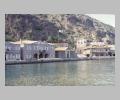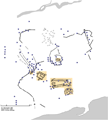| Summary: | Important fortified city in the Troad. |
| Type: | Fortified city |
| Region: | Troad |
Periods:
Archaic
Classical
Hellenistic
Roman
Physical:
Located on a low volcanic hill on the S coast of the Troad and ca. 11 km E of Lesbos, the fortified city of ca. 55 had occupied terraces extending steeply down to its 2 artificial harbors. N of the acropolis more gradual slopes lead down to the river Santioeis (modern Tuzla) and a large plain.
Description:
The acropolis of Assos was occupied in the Bronze Age, but first began to expand in the 8th and 7th centuries B.C. when Aeolian colonists from Methymna on Lesbos replaced the Carian inhabitants.
In the 6th century B.C. the city fell under Lydian and then Persian domination until it acquired independence when, following the Persian Wars, it became a member of the Delian League.
The oldest extant architectural remains of the city date to the mid 6th century B.C. and include the Doric temple of Athena on the acropolis, traces of domestic buildings, and sections of fortification walls.
The impressive and well preserved fortification walls at Assos are ca. 5 km in circumference with many square and round towers, 2 major gateways and 7 smaller gates. The walls, which date to the mid 4th century enclosed a large area to the N of the acropolis and all of the civic establishments (gymnasium, theater, agora and stoas, bouleuterion) of the lower town, S of the acropolis and extending down to the shore. The acropolis was separately fortified and the city's S walls protected the 2 small artificial harbors. At the harbors were facilities to transport ships overland in order to avoid the rough seas off the Troad. From the city's main NW gate a broad paved road lead through the principal necropolis to a 4th century B.C. stone bridge at the Satnioeis River, ca. 1 km to the N.
Assos reached its peak of fame in the 4th century B.C. In 365 B.C., under the banker-ruler Eubulus, it defended against a combined land and sea attack launched by the Persian satrap Autophradates and King Mausolus of Halicarnassus. In ca. 355-340 B.C., Hermias, the former eunuch-slave of Eubulus, ruled Assos and invited his former fellow students from Plato's Academy (including Aristotle, Xenocrates, Callisthenes, and Theophrastus) to join him in founding a philosophical school at Assos. The city became, for a short period, one of the main centers of culture in the Greek world. this came to an end in 341 B.C. when Hermias was captured and executed by the Persians.
After the death of Alexander, Assos fell under the control of the Seleucids, then Pergamon, and finally in 133 B.C. Rome. The city suffered commercial competition from Alexander Troas, but continued to prosper through the Roman period. Later, its fortifications served to deter Gaul and barbarian attacks.
Exploration:
Excavations: 1881-83, J. Clarke and F. Bacon, Archaeological Institute of America.
Sources Used:
Other Bibliography:





